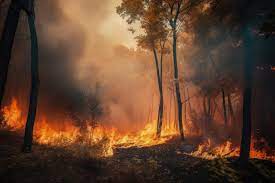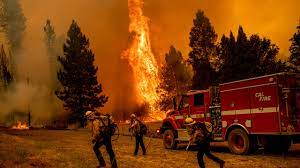California, famous for its magnificent lands and various bionetworks, is equally ill-famed for its wildfires. In new years, Artificial Intelligence (AI) has become an important tool in combating these unhelpful events. AI-generated burn models are now critical in understanding, forecasting, and managing wildfires in the state.
Causal Factors to Wildfires
- Climate Change: Higher temperatures and lengthy lack periods.
- Human Activities: Reasons include unattended campfires, rejected cigarettes, and faulty power lines.
- Vegetation: Dry, overgrown forests act as abundant fuel.
These factors have led to tragic fires, resulting in important loss of life, property, and natural homes.

The Role of AI in Wildfire Organization
AI technology is transforming wildfire management by examining large datasets to expect fire behavior and feast.
Data Collection and Analysis
AI systems gather data from various sources:
- Satellite Imagery: Monitors extensive areas for heat signatures.
- Weather Data: Ways temperature, wind, and wetness.
- Ground Devices: Detects soil dampness and temperature changes.
Analytical Modeling
Using the collected data, AI creates predictive models:
- Fire Spread Simulation: Forecasts the path of a wildfire.
- Risk Assessment: Identifies areas at high risk.
- Resource Allocation: Suggests ideal deployment of firefighting incomes.
Real-Time Checking
AI offers real-time updates on wildfire conditions:
- Alerts: Issues warnings to residents and authorities.
- Decision Support: Assists officials in making informed decisions.
- Damage Assessment: Estimates the fire’s impact.
AI-Generated Burn Models
AI-generated burn models simulate fire behavior by considering various factors:
- Topography: Land shape and features.
- Vegetation: Types and conditions of flora.
- Weather Conditions: Gust speed, temperature, and wetness.
Advantages of AI-Generated Burn Models
- Accuracy: Delivers precise fire behavior predictions.
- Speed: Provides real-time updates and forecasts.
- Scalability: Capable of monitoring large areas simultaneously.
Challenges in AI Implementation
Despite its benefits, AI in wildfire management faces challenges:
- Data Quality: Mistaken or incomplete data can slope forecasts.
- Integration: Merging AI with traditional firefighting methods.
- Cost: High initial investment for technology and training.

The Future of AI in Wildfire Organization
AI’s role in wildfire organization is set to increase, with ongoing technological advancements enhancing prediction accuracy and response times.
Potential Developments
- Advanced Algorithms: More sophisticated models for improved predictions.
- Integration with Drones: Enables real-time data collection and monitoring.
- Public Awareness: Educating communities about AI’s role in wildfire management.
Benefits for California
- Reduced Damage: Early detection and accurate predictions minimize losses.
- Better Resource Management: Efficient allocation of firefighting resources.
- Enhanced Safety: Protects lives and property through timely alerts and responses.
Normally Asked Questions
What is an AI-generated burn model?
AI-generated burn models simulate the behavior and spread of wildfires using data from sources like satellite imagery, weather reports, and ground sensors. They help understand fire movement, assess risk areas, and allocate resources effectively.
How accurate are AI-generated burn models?
The accuracy of these models depends on data quality and algorithm sophistication. High-quality data enables precise predictions, though inaccuracies or unexpected weather changes can affect reliability. Continuous advancements are improving model accuracy.
What are the main benefits of using AI in wildfire management?
AI offers several benefits:
- Early Detection: Identifies fires before they spread widely.
- Accurate Predictions: Helps understand fire behavior and spread.
- Efficient Resource Allocation: Guides the deployment of firefighters and equipment.
- Real-Time Checking: Provides continuous updates and alerts to improve response times.
What challenges does AI face in wildfire management?
AI faces challenges like:
- Data Quality: Mistaken or incomplete data can main to changeable guesses.
- Integration with Old-style Methods: Joining AI with existing firefighting techniques.
- Cost: High initial investment for technology and training.
- Public Trust: Building confidence in AI systems among residents and officials.
Addressing these challenges will enhance AI’s effectiveness in managing wildfires.

Decision
AI-generated burn models are transforming wildfire management in California. By leveraging data and logical analytics, these models provide correct and timely information, California meaningfully dropping the shocking impact of wildfires. As technology advances, AI will play an gradually important role in protection California’s groups and natural landscapes.

Excellent
[…] to their preferences. But what determines which videos appear? Let us find the secrets last TikTok’s FYP […]
Excellent
Self-harm leading to death is a tragic topic that impacts millions of people around the globe.
It is often associated with emotional pain, such as depression, trauma, or chemical dependency.
People who struggle with suicide may feel trapped and believe there’s no other way out.
how-to-kill-yourself.com
It is important to talk openly about this subject and support those in need.
Early support can make a difference, and reaching out is a crucial first step.
If you or someone you know is in crisis, please seek help.
You are not alone, and help is available.